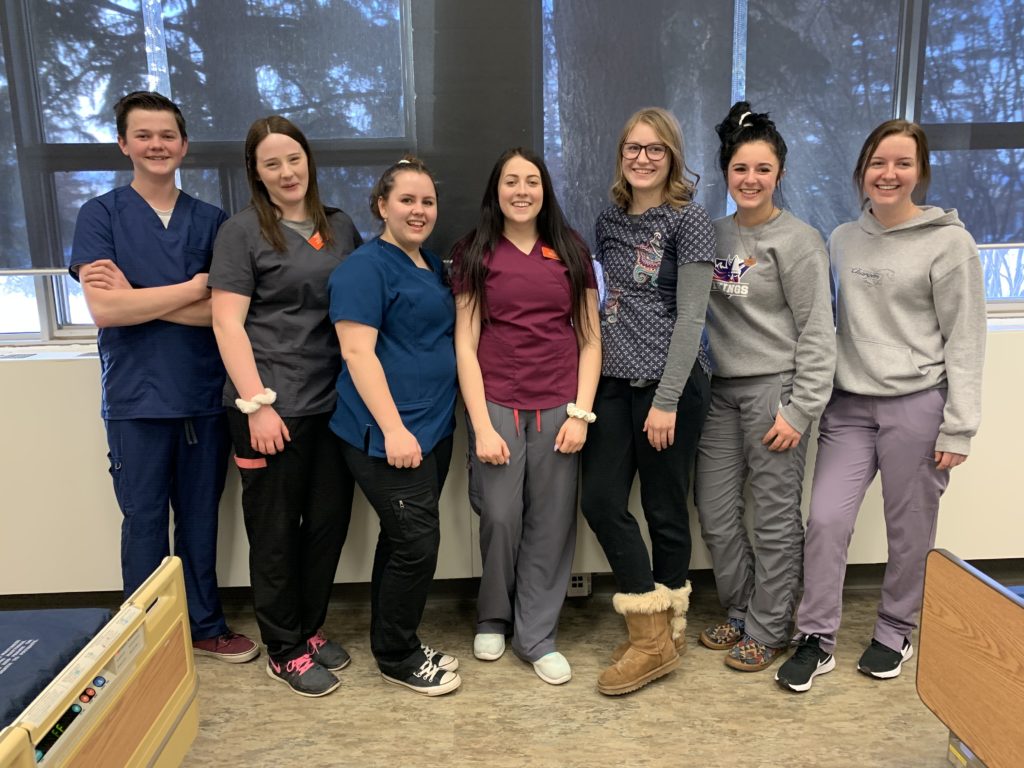
When it comes to health care, the pathway to a career looks different for everyone.
For high school students in the Chinook’s Edge School Division (CESD), the road to a health-care career can start early; the schools in this division offer a dual-credit Health-care Aide (HCA) Program that prepares students to become part of the health-care team.
“I found out about the opportunity and I’ve always had an interest in medicine, so that’s what got me [to enroll],” says Nathan Turgeon, a Grade-11 Sundre High School student who aspires to become a surgeon.
“It’s actually really fun,” he continues. “I mean there are certain challenges [as compared to regular] high school [courses], but it’s not too bad. It’s better than I expected and a nice change.”
A provincial initiative that’s endorsed by Alberta Education and Advanced Education, dual-credit programming allows students in Grades 10, 11, or 12 to earn high school and post-secondary credits concurrently.
“[Students] are entering into [post-secondary education], so being prepared for what those expectations are is important,” says Jackie Taylor, director of Community Learning Campus, a joint venture between Olds College and CESD. “We do a lot of vetting of students to make certain that the program is the right fit for them and also to make sure their high school [requirements] are in place.”
[Students] leverage this [program] as the first stepping stone, because it helps them to confirm if they’re in the right place.
– Jackie Taylor
With the school division covering the cost of tuition, and the province reimbursing a portion upon completion, Taylor affirms that schools see great value in dual-credit programs, because they help students get started on their future career goals.
“Most of these [HCA Program] students, if not all, are headed into other health-related careers, whether it’s registered nursing (RN), … [licensed practical nursing], or [medicine] down the road,” says Taylor. “They leverage this [program] as the first stepping stone, because it helps them to confirm if they’re in the right place.
“The experiences they get, particularly in their practicum, really help to solidify that so they’re confident and assured of themselves as they head into post-secondary,” Taylor adds.
“I plan on going for my RN [Degree] after high school,” says Taylor Guzmanuk, a Grade-11 student at Sundre High School. “So I thought that this would be a good step to see if it’s something that I would love to do.
“It’s a lot of time and really different than high school,” she continues, adding that she hopes to work as an HCA while she finishes high school and enters into post-secondary training.
“But once you get into the flow of it, and if you love it, it’s easy.”
It lets you see what happens on site and what happens in a team environment working with different disciplines.
– Chantal Crawford
Through the use of practicums during the HCA Program, and the opportunity to work in health-care facilities upon completion, the dual-credit program gives students a more realistic view of what working in health care is like and how all the various disciplines work together.
“It lets you see what happens on site and what happens in a team environment working with different disciplines,” says Chantal Crawford, site manager of the Sundre Hospital and Care Centre where Turgeon completed his practicum. “It also helps [students] to develop the tools they need to move forward in their careers, because it builds the foundation for what we do [in all health-care fields].”
From dual-credit programs to Rural Health Professions Action Plan (RhPAP) events, students today have more options than ever when it comes to building a career in health care—something Guzmanuk says everyone should take advantage of.
“Look into every option,” she says, explaining that she’s taken part in several RhPAP High School Skills Events in the past. “There are so many different dual-credit programs. There are skills days. You can shadow people or do a workplace experience. Anything to see if that’s what you want to do.”
To learn more about dual-credit programs and other learning opportunities available in each district and school, students are encouraged to talk to their student advisor, counsellor, or school administrator to learn more about their options.
– Lesley Allan
